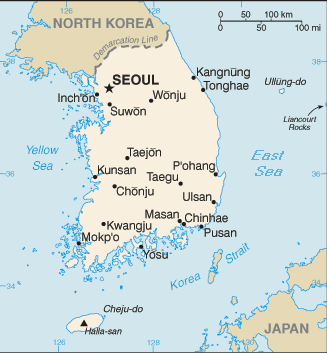|
Korea, South
|

|
Capital: Seoul
Population: 51,225,308
Brief History of Korea, South:
South Korea is located on the southern part of the Korean Peninsula.
During the 1st century AD, Korea was divided into three kingdoms. They were Shilla, Koguryo, and Pekche. The area remained this way until 668 AD when Korea was unified by the Shilla Kingdom. The Shilla kingdom was followed by the Koryo kingdom in 935 and then by the Choson dynasty in 1392. The name Korea comes from the Koryo kingdom.
Korea was invaded and conquered by other larger empires and countries throughout its history. The Mongol Empire ruled over Korea from 1231 until the 14th century and Japan invaded in the 1500s. In the 1900s both the Chinese and the Russians tried to invade Korea. In both cases the Japanese fought them off and took Korea as part of the Japanese Empire.
When Japan lost World War II, Korea was divided into two zones. The Soviet Union took control of the north and the United States the south. They were divided at the 38th parallel. This was meant to be a temporary division, but it is still there today. South Korea is the country that is south of the 38th parallel.
In 1950 South Korea was invaded by North Korea and the Korean War began. It was the first major conflict of the Cold War. With the help of United Nations forces, the South Koreans fought back and regained their territory. Today there is a two mile demilitarized zone between the two countries at the 38th parallel.
South Korea became an independent country in 1948. The first president of South Korea was Syngman Rhee. Today South Korea has a fairly strong economy growing in technology.
The Geography of Korea, South
Total Size: 98,480 square km
Size Comparison: slightly larger than Indiana
Geographical Coordinates: 37 00 N, 127 30 E
World Region or Continent: Asia
General Terrain: mostly hills and mountains; wide coastal plains in west and south
Geographical Low Point: East Sea 0 m
Geographical High Point: Halla-san 1,950 m
Climate: temperate, with rainfall heavier in summer than winter
Major cities: SEOUL (capital) 9.778 million; Busan (Pusan) 3.439 million; Incheon (Inch'on) 2.572 million; Daegu (Taegu) 2.458 million; Daejon (Taejon) 1.497 millio
The People of Korea, South
Type of Government: republic
Languages Spoken: Korean, English widely taught in junior high and high school
Independence: 15 August 1945 (from Japan)
National Holiday: Liberation Day, 15 August (1945)
Nationality: Korean(s)
Religions: no affiliation 46%, Christian 26%, Buddhist 26%, Confucianist 1%, other 1%
National Symbol: taegeuk (yin yang symbol)
National Anthem or Song: Aegukga (Patriotic Song)
Economy of Korea, South
Major Industries: electronics, telecommunications, automobile production, chemicals, shipbuilding, steel
Agricultural Products: rice, root crops, barley, vegetables, fruit; cattle, pigs, chickens, milk, eggs; fish
Natural Resources: coal, tungsten, graphite, molybdenum, lead, hydropower potential
Major Exports: semiconductors, wireless telecommunications equipment, motor vehicles, computers, steel, ships, petrochemicals
Major Imports: machinery, electronics and electronic equipment, oil, steel, transport equipment, organic chemicals, plastics
Currency: South Korean won (KRW)
National GDP: $1,554,000,000,000
** Source for population (2012 est.) and GDP (2011 est.) is CIA World Factbook.
Back to Geography Home Page
